 |
 |




|
 Loading Page. Please Wait... Loading Page. Please Wait... 
|
General Site Information  | |
|---|---|
| Domain: | ragpiano.com |
| Established: | June 1997 |
| Provider: | iPowerWeb |
| Author: | All content written, coded, illustrated, maintained and posted by Bill Edwards |
| Browser Information | |
| Browser: | |
| Cookies: | |
| Language: | |

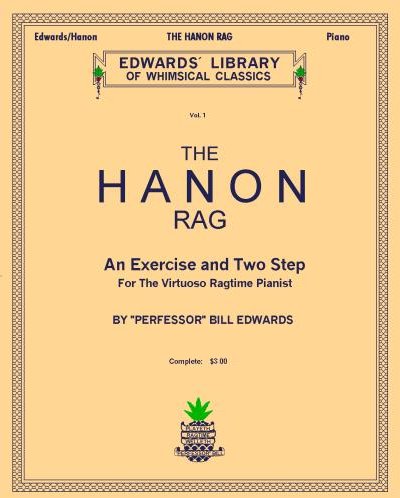 Without the ability to read the music, or to be able to place your hands on the keys without being constantly conscious of the mechanics of playing, progress will be impeded and the ragtime learning curve will be inordinately steep. Also important to the foundation is the content of what you've learned. People who learn by rote (listening to or watching and therefore learning by example) may have a more difficult time capturing the essence of pieces that they have not heard. Therefore, the ability to read music, while not critical, is certainly an inherently useful factor.
Without the ability to read the music, or to be able to place your hands on the keys without being constantly conscious of the mechanics of playing, progress will be impeded and the ragtime learning curve will be inordinately steep. Also important to the foundation is the content of what you've learned. People who learn by rote (listening to or watching and therefore learning by example) may have a more difficult time capturing the essence of pieces that they have not heard. Therefore, the ability to read music, while not critical, is certainly an inherently useful factor.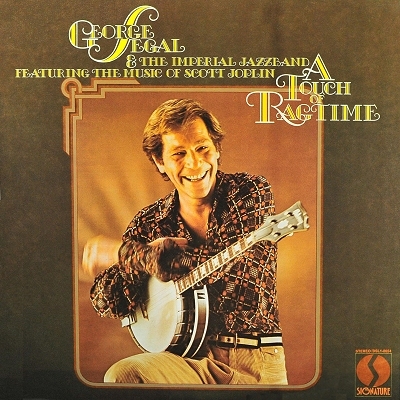 Otherwise, listen to that which has already been laid out for you; and not just from one artist. A young Dave Jasen visited the 1950s rag pianist Lou Busch (who most often recorded as Joe "Fingers" Carr) and demonstrated how accurately he could reproduce his mentor's performances. Busch then turned the lights on for Dave by telling him he would do much better to create his own style, which Jasen obviously did in the following years as he became a ragtime scholar. So listen to more than just one artist and emulate the aspects of each one of them that appeal to you. Collectively, the fusion of all this will become your style.
Otherwise, listen to that which has already been laid out for you; and not just from one artist. A young Dave Jasen visited the 1950s rag pianist Lou Busch (who most often recorded as Joe "Fingers" Carr) and demonstrated how accurately he could reproduce his mentor's performances. Busch then turned the lights on for Dave by telling him he would do much better to create his own style, which Jasen obviously did in the following years as he became a ragtime scholar. So listen to more than just one artist and emulate the aspects of each one of them that appeal to you. Collectively, the fusion of all this will become your style. Something that is essential to creating good ragtime performance habits is a metronome. If your electronic keyboard has one, use it. If you need one for your piano, they are relatively cheap, and many apps are available for tablets or mobile phones. Set it slow. Start it at maybe 90 to 100 metronome ticks for eighth notes in 2/4 time, increasing speed as you improve, and switching to quarter note beats as you gain confidence. Once you have it down cold, wean yourself slowly from the metronome making sure you avoid the tendency to speed up during a performance. Then you will need to work on memorization.
Something that is essential to creating good ragtime performance habits is a metronome. If your electronic keyboard has one, use it. If you need one for your piano, they are relatively cheap, and many apps are available for tablets or mobile phones. Set it slow. Start it at maybe 90 to 100 metronome ticks for eighth notes in 2/4 time, increasing speed as you improve, and switching to quarter note beats as you gain confidence. Once you have it down cold, wean yourself slowly from the metronome making sure you avoid the tendency to speed up during a performance. Then you will need to work on memorization. This brings us back to listening. Once you have learned the music, utilize rote methodology to reinforce what you've learned. Either make a recording of yourself or select a recording of the piece in the style you want to emulate, then play it back repeatedly. I always have new projects on my iPod or CD-Rs playing in my car. Also, play along with the recording repeatedly (if you can match your instrument pitch with your playback device). You will memorize the piece well enough eventually. The repetition also creates a muscle memory, in which the brain processes a certain sequence of muscle impulses to create a set musical passage. That muscle memory can surprisingly persist for years at a time in some individuals.
This brings us back to listening. Once you have learned the music, utilize rote methodology to reinforce what you've learned. Either make a recording of yourself or select a recording of the piece in the style you want to emulate, then play it back repeatedly. I always have new projects on my iPod or CD-Rs playing in my car. Also, play along with the recording repeatedly (if you can match your instrument pitch with your playback device). You will memorize the piece well enough eventually. The repetition also creates a muscle memory, in which the brain processes a certain sequence of muscle impulses to create a set musical passage. That muscle memory can surprisingly persist for years at a time in some individuals.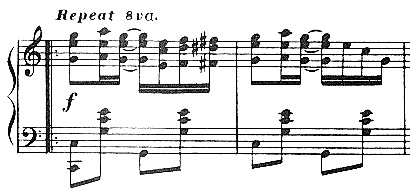 Octave Shifts: This is one of the easiest forms of pseudo-improvisation. A number of ragtime scores, such as Scott Joplin's The Entertainer (Hover over or finger tap the examples to enlarge) actually suggest this with the notation Repeat 8va (play the right hand line an octave higher). This simple variation both provides contrast and interest. You can often do the same with the left hand by playing the left-hand bass notes (not the chords) an octave lower (8vb) on the repeat, although this obviously takes more practice for accuracy given the greater distance between the bass notes and the chords. There are other creative uses of octave shifts available as well.
Octave Shifts: This is one of the easiest forms of pseudo-improvisation. A number of ragtime scores, such as Scott Joplin's The Entertainer (Hover over or finger tap the examples to enlarge) actually suggest this with the notation Repeat 8va (play the right hand line an octave higher). This simple variation both provides contrast and interest. You can often do the same with the left hand by playing the left-hand bass notes (not the chords) an octave lower (8vb) on the repeat, although this obviously takes more practice for accuracy given the greater distance between the bass notes and the chords. There are other creative uses of octave shifts available as well. In some cases, such as the C section or trio of Joplin's Pine Apple Rag where the hands are playing together in relatively close proximity, you can shift both of them up an octave. However, octave shifts are rarely done for the full sixteen measures of a section. Most ragtime performers consider a shift back to the original octave for the last four to eight measures of a section to be a good practice. Where this technique is applied depends largely on the nature of each piece, but it should be readily apparent with a little study.
In some cases, such as the C section or trio of Joplin's Pine Apple Rag where the hands are playing together in relatively close proximity, you can shift both of them up an octave. However, octave shifts are rarely done for the full sixteen measures of a section. Most ragtime performers consider a shift back to the original octave for the last four to eight measures of a section to be a good practice. Where this technique is applied depends largely on the nature of each piece, but it should be readily apparent with a little study.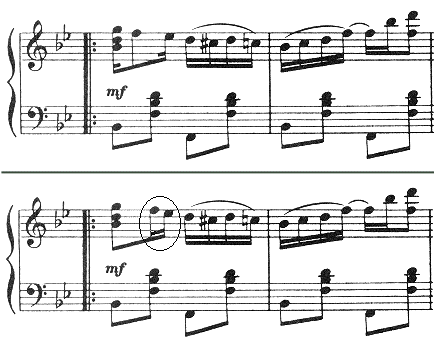 Altering Syncopation: This is a somewhat trickier area of improvisation, and one that should be approached with deliberate caution. As an example, I'll again use Scott Joplin's Pine Apple Rag. The second note of the main theme [F] is the initial syncopation. By shifting that note over by a sixteenth, the first two notes of the measure then create a strict eighth note pattern, which removes at least half of the syncopation from the A section if applied to each iteration of this pattern. This alteration, or straightening out of the syncopation, can offer a nice variation here and there, but can also turn a piece into more of a march than a rag. There are, however, instances were such a subtle change can provide some desired variety. Using the same passage, if the initial right hand chord of the third measure [Bb6] is played just a sixteenth ahead of that measure, you will be adding a syncopation which actually increases the "ragginess" of the piece with what is called an anticipatory syncopation, one that extends over the bar line. But don't overdo this effect as it can detract from the composer's intentions and sound overly derisive.
Altering Syncopation: This is a somewhat trickier area of improvisation, and one that should be approached with deliberate caution. As an example, I'll again use Scott Joplin's Pine Apple Rag. The second note of the main theme [F] is the initial syncopation. By shifting that note over by a sixteenth, the first two notes of the measure then create a strict eighth note pattern, which removes at least half of the syncopation from the A section if applied to each iteration of this pattern. This alteration, or straightening out of the syncopation, can offer a nice variation here and there, but can also turn a piece into more of a march than a rag. There are, however, instances were such a subtle change can provide some desired variety. Using the same passage, if the initial right hand chord of the third measure [Bb6] is played just a sixteenth ahead of that measure, you will be adding a syncopation which actually increases the "ragginess" of the piece with what is called an anticipatory syncopation, one that extends over the bar line. But don't overdo this effect as it can detract from the composer's intentions and sound overly derisive. Another method of adding syncopation to a phrase is to delay the first note or chord of a measure by a sixteenth, an effect which can be applied to either hand depending on the context of the passage. Yet one other advanced technique is to make the first beat of a measure a blank sixteenth rest in both hands. Classic rag composer Joseph F. Lamb actually used this in the opening of one of his last pieces, The Alaskan Rag from 1959.
Another method of adding syncopation to a phrase is to delay the first note or chord of a measure by a sixteenth, an effect which can be applied to either hand depending on the context of the passage. Yet one other advanced technique is to make the first beat of a measure a blank sixteenth rest in both hands. Classic rag composer Joseph F. Lamb actually used this in the opening of one of his last pieces, The Alaskan Rag from 1959.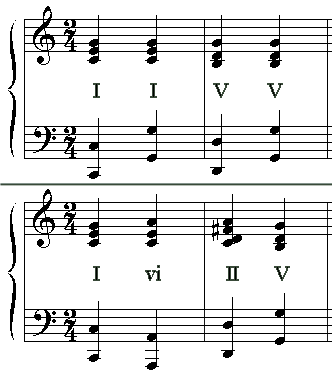 You can also add sixths to a chord for no particular reason. Sixths are quite effective with minor chords, as I have applied them throughout the A and B sections of Artie Matthews' Pastime Rag #3. Major sevenths are rarely used, and ninths should typically be relegated to pieces in which they are written, such as Eubie Blake's Charleston Rag. In most cases, harmonic alteration should be done in the context of a passing tone, which is where the note or chord after the alteration resolves to the next expected note or chord. You can occasionally alter a full chord progression in the same context. For example, instead of two measures in the middle of a section using a | I I | V V | harmonic progression, try altering the harmonies for both hands to achieve a | I vi | II V | cadence*. Experiment, but always be careful to not stray too far outside of obvious boundaries, except maybe in the case of an original composition. If a harmony is out of place, it should be readily apparent, particularly when you play back a recording of your performance.
You can also add sixths to a chord for no particular reason. Sixths are quite effective with minor chords, as I have applied them throughout the A and B sections of Artie Matthews' Pastime Rag #3. Major sevenths are rarely used, and ninths should typically be relegated to pieces in which they are written, such as Eubie Blake's Charleston Rag. In most cases, harmonic alteration should be done in the context of a passing tone, which is where the note or chord after the alteration resolves to the next expected note or chord. You can occasionally alter a full chord progression in the same context. For example, instead of two measures in the middle of a section using a | I I | V V | harmonic progression, try altering the harmonies for both hands to achieve a | I vi | II V | cadence*. Experiment, but always be careful to not stray too far outside of obvious boundaries, except maybe in the case of an original composition. If a harmony is out of place, it should be readily apparent, particularly when you play back a recording of your performance.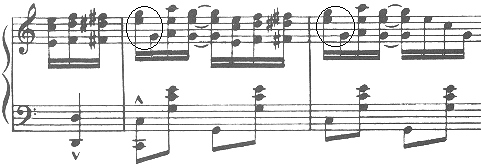 and help to enhance the forward motion of a piece without necessarily altering its melodic content. For the most part, they are simply enhanced arpeggios or octave notes that reflect the current harmonies within the chord for that particular beat. As an example, we'll use the B section of Joplin's The Entertainer since it is so well known. After the first four leading chords into that section are played stepwise up to a G one and a half octaves above Middle C, the next sixteenth beat, which is normally empty, could be filled with the G just above Middle C, an octave lower than the melody, played by the thumb. There are five more opportunities to do this throughout the section. It changes the character of your playing without significantly altering the familiarity of the piece.
and help to enhance the forward motion of a piece without necessarily altering its melodic content. For the most part, they are simply enhanced arpeggios or octave notes that reflect the current harmonies within the chord for that particular beat. As an example, we'll use the B section of Joplin's The Entertainer since it is so well known. After the first four leading chords into that section are played stepwise up to a G one and a half octaves above Middle C, the next sixteenth beat, which is normally empty, could be filled with the G just above Middle C, an octave lower than the melody, played by the thumb. There are five more opportunities to do this throughout the section. It changes the character of your playing without significantly altering the familiarity of the piece.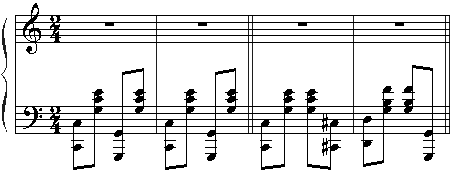 Left Hand Tips: Don't forget your accompanist to the melody. You are likely familiar with the two basic ragtime patterns, Oom Pah Oom Pah and Oom Pah Pah Oom. The oom-pah term is European in origin, describing the sound where a tuba would play the bass notes, followed by a chord instrument, such as an accordion. In American culture the chord instrument was most frequently the banjo from the late-19th century well into the 1920s. There is plenty that your left hand can do to inject variety into your performance and break away from that pattern. For starters, you can replace the chords of a typical oom-pah bass line with octave notes that act as passing notes where those chords would normally be. Even if it replaces only one of the chords of a measure it can provide a pleasant change of pace. You can also alter the left hand rhythm by playing a three against four pattern in two measure segments as follows:
Left Hand Tips: Don't forget your accompanist to the melody. You are likely familiar with the two basic ragtime patterns, Oom Pah Oom Pah and Oom Pah Pah Oom. The oom-pah term is European in origin, describing the sound where a tuba would play the bass notes, followed by a chord instrument, such as an accordion. In American culture the chord instrument was most frequently the banjo from the late-19th century well into the 1920s. There is plenty that your left hand can do to inject variety into your performance and break away from that pattern. For starters, you can replace the chords of a typical oom-pah bass line with octave notes that act as passing notes where those chords would normally be. Even if it replaces only one of the chords of a measure it can provide a pleasant change of pace. You can also alter the left hand rhythm by playing a three against four pattern in two measure segments as follows: | Bass Chord Chord Bass | Chord Chord Bass Chord |
| Bass Chord Chord Bass | Chord Chord Bass Chord |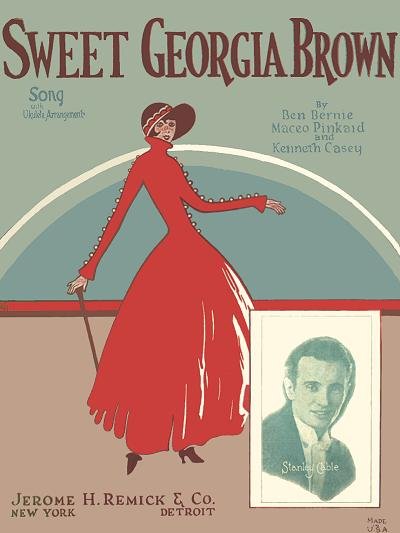 Learn the Entire Song: Most of the classic songs in the standard sing-along repertoire have made it through a century and more with the chorus intact. This is usually because that chorus is repeated most often, and it contains the melodic "hook" that made the song a recognizable hit to begin with. But playing choruses will likely lead into medleys rather than individual performances, due to their abbreviated length. This means that you'll have to learn more songs to fill out a set or an evening. However, virtually all of the songs from the early 1900s had verses. The verse can often change the context of a song, adding a new level of interest and telling more of a story. For example, In My Merry Oldsmobile contains a great deal of mild sexual innuendo in the verses that effectively spill over into the chorus once they have been heard. Few listeners today realize that Sweet Georgia Brown is actually about a black prostitute of high standing, as the verses reveal. In addition, verses can help add significantly to the length of a song, thus expanding your performance time and reducing the need for either an expansive repertoire or repeat performances in the same evening. For example, Put On Your Old Grey Bonnet has a rather terse chorus, and it turns out that the verse is twice as long. You will often find the listeners fascinated with the fact that you know verses, and it will add volumes to the content of your performance of old-time songs.
Learn the Entire Song: Most of the classic songs in the standard sing-along repertoire have made it through a century and more with the chorus intact. This is usually because that chorus is repeated most often, and it contains the melodic "hook" that made the song a recognizable hit to begin with. But playing choruses will likely lead into medleys rather than individual performances, due to their abbreviated length. This means that you'll have to learn more songs to fill out a set or an evening. However, virtually all of the songs from the early 1900s had verses. The verse can often change the context of a song, adding a new level of interest and telling more of a story. For example, In My Merry Oldsmobile contains a great deal of mild sexual innuendo in the verses that effectively spill over into the chorus once they have been heard. Few listeners today realize that Sweet Georgia Brown is actually about a black prostitute of high standing, as the verses reveal. In addition, verses can help add significantly to the length of a song, thus expanding your performance time and reducing the need for either an expansive repertoire or repeat performances in the same evening. For example, Put On Your Old Grey Bonnet has a rather terse chorus, and it turns out that the verse is twice as long. You will often find the listeners fascinated with the fact that you know verses, and it will add volumes to the content of your performance of old-time songs.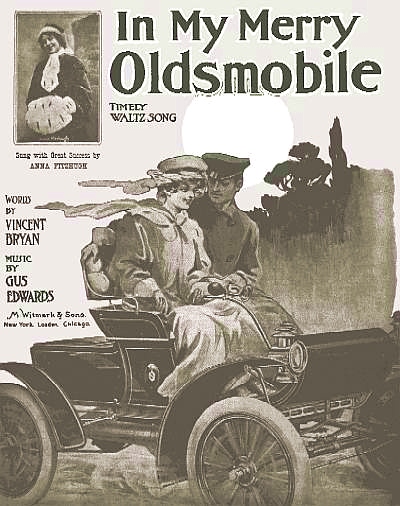 Formatting: Now that you have more content to use in your arrangement, the next step is to find a format that will fit the song you're using. Rarely do you want to start a song without a four to eight bar introduction. It helps to establish key, tempo and style for the listener as well as for the performer. If you have the sheet music for your songs or a book that reproduces the sheet music, the original introduction is likely included. You can use this as a template for the introduction you want to include for a particular song. Follow the introduction with the verse. Unless the music specifically places the chorus up front, starting with the verse allows you more latitude in what you can do before you establish the most familiar part of the song. In my performance of In My Merry Oldsmobile, I apply rubato to the first verse, which contrasts with the establishment of tempo in the chorus. Then I take part of the second verse into 4/4 time to contrast with the 3/4 found throughout the piece. The verses allow me this latitude where simply playing the chorus repeatedly will not. In the case of ensemble performances, as opposed to solo piano, the verse is usually played just once, and often in the middle of the arrangement. This will occasionally work with piano alone, but is less interesting and lacks the flexibility of arrangement, much less the story-telling elements made available by putting the verse first. It also adds a bit of mystery, and can become a guessing game for the listener as well.
Formatting: Now that you have more content to use in your arrangement, the next step is to find a format that will fit the song you're using. Rarely do you want to start a song without a four to eight bar introduction. It helps to establish key, tempo and style for the listener as well as for the performer. If you have the sheet music for your songs or a book that reproduces the sheet music, the original introduction is likely included. You can use this as a template for the introduction you want to include for a particular song. Follow the introduction with the verse. Unless the music specifically places the chorus up front, starting with the verse allows you more latitude in what you can do before you establish the most familiar part of the song. In my performance of In My Merry Oldsmobile, I apply rubato to the first verse, which contrasts with the establishment of tempo in the chorus. Then I take part of the second verse into 4/4 time to contrast with the 3/4 found throughout the piece. The verses allow me this latitude where simply playing the chorus repeatedly will not. In the case of ensemble performances, as opposed to solo piano, the verse is usually played just once, and often in the middle of the arrangement. This will occasionally work with piano alone, but is less interesting and lacks the flexibility of arrangement, much less the story-telling elements made available by putting the verse first. It also adds a bit of mystery, and can become a guessing game for the listener as well. When you reach the chorus, you can usually play it through at least two times before playing the verse again, applying some form of improvisation or alteration to the second iteration. In the case of some thirty-two bar choruses, it may be better to save your repeats until after a second iteration of the verse. In the case of either sixteen or thirty-two bar choruses, you may also go back to the last half of that chorus for your repeat. If you are singing the piece, a piano solo repeat or break between the first and second verses is advisable, and allows you to show off your playing technique. It also adds to the contrast that can create interest in your performance. On most songs, with the exception of the more tender ballads, try to end big. Big chords; lots of sound; high notes; etc. Modulate upwards either for the last chorus or in the middle of it if possible. All of these techniques are applied to my ensemble performance of Bill Bailey, Won't You Please Come Home. On ballads, however, you can still go at it on the last chorus using your best maudlin style, but bring it down at the very end and apply soft dynamics and rubato for an effect that should make most of your audience weepy if correctly applied. Listen to my renditions of M-O-T-H-E-R or Sonny Boy to hear what I am referring to.
When you reach the chorus, you can usually play it through at least two times before playing the verse again, applying some form of improvisation or alteration to the second iteration. In the case of some thirty-two bar choruses, it may be better to save your repeats until after a second iteration of the verse. In the case of either sixteen or thirty-two bar choruses, you may also go back to the last half of that chorus for your repeat. If you are singing the piece, a piano solo repeat or break between the first and second verses is advisable, and allows you to show off your playing technique. It also adds to the contrast that can create interest in your performance. On most songs, with the exception of the more tender ballads, try to end big. Big chords; lots of sound; high notes; etc. Modulate upwards either for the last chorus or in the middle of it if possible. All of these techniques are applied to my ensemble performance of Bill Bailey, Won't You Please Come Home. On ballads, however, you can still go at it on the last chorus using your best maudlin style, but bring it down at the very end and apply soft dynamics and rubato for an effect that should make most of your audience weepy if correctly applied. Listen to my renditions of M-O-T-H-E-R or Sonny Boy to hear what I am referring to.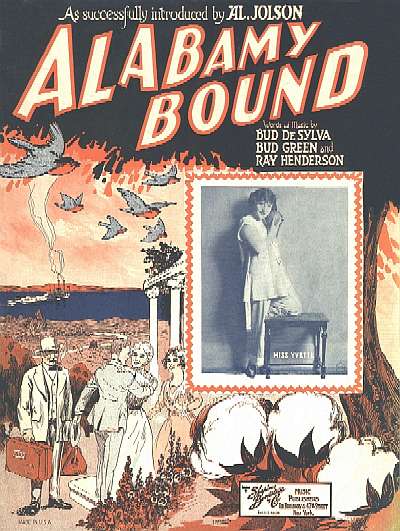 Arranging: This is a highly personal aspect of performance that largely depends on the individual talent, experience, technical and creative abilities of the performer. I love to arrange, and nearly every piece I play falls within a particular format that I have set for that piece. It is fun to add lots of flash to otherwise average songs, but one can get too gimmicky if not careful. I apply a lot of classical ideas to my introductions, and occasionally some familiar quotes (as noted above). It depends on your target audience as well. If you are competing with other pianists in a contest of some kind, then arrangements should be as innovative and individual as you can make them without losing the basic song in the arrangement. If you are instead playing background music, over-arranging will contribute to continuing unemployment as a lounge pianist. Try to make your arrangement tell some kind of story, the application of which will help to achieve a thread of continuity throughout. Take some fundamental element of the piece to use as a basis for direction. For example, I took the main lyrical theme of Alabamy Bound, riding on a train, and applied that theme directly to the music by creating train sound effects in the beginning and end. I further enhanced the arrangement by dramatizing the fabulous minor verse with big chords and contrasting dynamics. A similar treatment worked well for California, Here I Come. As for creating your own arrangements, experiment and have fun with these concepts. But in the beginning, try them out on your friends and family before you go public with them.
Arranging: This is a highly personal aspect of performance that largely depends on the individual talent, experience, technical and creative abilities of the performer. I love to arrange, and nearly every piece I play falls within a particular format that I have set for that piece. It is fun to add lots of flash to otherwise average songs, but one can get too gimmicky if not careful. I apply a lot of classical ideas to my introductions, and occasionally some familiar quotes (as noted above). It depends on your target audience as well. If you are competing with other pianists in a contest of some kind, then arrangements should be as innovative and individual as you can make them without losing the basic song in the arrangement. If you are instead playing background music, over-arranging will contribute to continuing unemployment as a lounge pianist. Try to make your arrangement tell some kind of story, the application of which will help to achieve a thread of continuity throughout. Take some fundamental element of the piece to use as a basis for direction. For example, I took the main lyrical theme of Alabamy Bound, riding on a train, and applied that theme directly to the music by creating train sound effects in the beginning and end. I further enhanced the arrangement by dramatizing the fabulous minor verse with big chords and contrasting dynamics. A similar treatment worked well for California, Here I Come. As for creating your own arrangements, experiment and have fun with these concepts. But in the beginning, try them out on your friends and family before you go public with them. Printed Music Use: As noted earlier, memorization is the best possible way to make music out of a pile of sequential notes, since you don't have to focus on the syntax of those notes. However, even if you have a decent memory, you can't learn and retain everything, and may sometimes get asked for material you are less familiar with. In the 1970s there appeared notebooks of charts consisting of chords and melodies with words. By the 1980s these were published and distributed as fake books, and came in several different flavors, usually with two to three tunes on each page, sometimes with verses. However, given not only the volume of new music that becomes a hit, then a favorite, then a standard, even in the second decade of the 21st century (look how fast All About That Bass became an oldie, of sorts), and the rediscoveries of older tunes that become popular again, no paper fake book can keep up with that, and hauling forty pounds of paper to every gig, much less thumbing through it, can stop the pace of the evening the same as writing a check at McDonalds would.
Printed Music Use: As noted earlier, memorization is the best possible way to make music out of a pile of sequential notes, since you don't have to focus on the syntax of those notes. However, even if you have a decent memory, you can't learn and retain everything, and may sometimes get asked for material you are less familiar with. In the 1970s there appeared notebooks of charts consisting of chords and melodies with words. By the 1980s these were published and distributed as fake books, and came in several different flavors, usually with two to three tunes on each page, sometimes with verses. However, given not only the volume of new music that becomes a hit, then a favorite, then a standard, even in the second decade of the 21st century (look how fast All About That Bass became an oldie, of sorts), and the rediscoveries of older tunes that become popular again, no paper fake book can keep up with that, and hauling forty pounds of paper to every gig, much less thumbing through it, can stop the pace of the evening the same as writing a check at McDonalds would. The answer to this is to consider a 10" or larger tablet, such as an Apple iPad, Sony Experia, Samsung Galaxy, etc. While not as cheap as a phone, they most certainly outweigh the combined cost and difficult of maintenance and material upkeep for fake books. Music for more than three centuries of literature is available in PDF format, a surprising amount of it for free. If you roll your own PDF files, it is helpful to trim the images so there are almost no margins, since they will display the music larger. Quickest way to a finished multi-page file is to import images one page at a time into a Word file with 0" margins, then save as using the .pdf format. There are a number of fine programs you can download that will manage and categorize your files, and make searching for them, even using voice, a snap. You can even put together set lists for continual scrolling if you like. Experience has proven to me that a finger swipe is much easier to execute in a hurry than a page turn, and you can even get foot pedals to do that work for you. Add in the convenience of apps like hyper-accurate tuners, metronomes with both sound and display, and playback capability of several types of files, the you have a total music winner that weighs less than two pounds, but can store thousands of song files, any of them accessible in seconds. You can even add annotations. There are dozens of services as well that can keep you fed with charts - some in any key - for the latest material. Also, you don't absolutely have to get one with a 4G or similar monthly connection plan, as all of them will work fine with a WiFi signal. And when you are not using it for performance, you can watch YouTube cat videos anywhere, making it a true win!
The answer to this is to consider a 10" or larger tablet, such as an Apple iPad, Sony Experia, Samsung Galaxy, etc. While not as cheap as a phone, they most certainly outweigh the combined cost and difficult of maintenance and material upkeep for fake books. Music for more than three centuries of literature is available in PDF format, a surprising amount of it for free. If you roll your own PDF files, it is helpful to trim the images so there are almost no margins, since they will display the music larger. Quickest way to a finished multi-page file is to import images one page at a time into a Word file with 0" margins, then save as using the .pdf format. There are a number of fine programs you can download that will manage and categorize your files, and make searching for them, even using voice, a snap. You can even put together set lists for continual scrolling if you like. Experience has proven to me that a finger swipe is much easier to execute in a hurry than a page turn, and you can even get foot pedals to do that work for you. Add in the convenience of apps like hyper-accurate tuners, metronomes with both sound and display, and playback capability of several types of files, the you have a total music winner that weighs less than two pounds, but can store thousands of song files, any of them accessible in seconds. You can even add annotations. There are dozens of services as well that can keep you fed with charts - some in any key - for the latest material. Also, you don't absolutely have to get one with a 4G or similar monthly connection plan, as all of them will work fine with a WiFi signal. And when you are not using it for performance, you can watch YouTube cat videos anywhere, making it a true win! |
The Ragtime Webring-Dedicated to Scott Joplin and the music of the Ragtime Era, this ring is an invaluable resource for jazz music lovers, musicians and historians. Sheet music, midi files, afro-american history, record collectors... |
| | Previous | Next | Random Site | Ring Hub | Add Your Ragtime Site | | |
|
There are lots of great ragtime recordings by top artists available from

Including some of my recommended favorites: And don't miss these movies which include some ragtime music:
|
|
Or just search their site using the search engine below! |

|